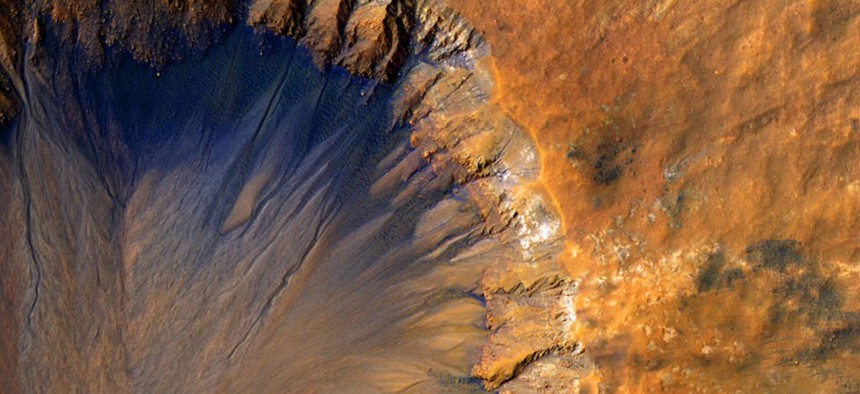
A crater in the Sirenum Fossae region of Mars. NASA/JPL/University of Arizona
NASA Announces That Water Is Flowing on Mars
In a major scientific finding, researchers confirm briny water flows seasonally on the Red Planet.
Right now, 140 million miles away, somewhere on the frigid surface of Mars, there is water forming. Scientists announced they have strong evidence that briny water flows on the planet, a critical step toward identifying possible life on Mars.
“Water is essential to life as we know it,” wrote Lujendra Ojha, Mary Beth Wilhelm, and their co-authors in a paper published Monday in Nature Geoscience. “ The presence of liquid water on Mars today has astrobiological, geologic, and hydrologic implications and may affect future human exploration.”
If this announcement, which NASA billed as “major” in the days leading up to it, sounds not altogether new, it’s because scientists have been obsessing over the water on Mars for decades. (The sight of ice volcanoes on Pluto this summer had scientists similarly elated.) Astrobiologists have long suspected that Mars was at least partially covered in water at one time—markings on the planet indicate the presence of ancient streambeds. A billion years ago, scientists believe the planet may have had a roiling, primitive ocean. Meandering formations on the surface of Mars suggested water flowed on the planet for a geologically significant period of time. Long enough, perhaps, to have sustained bacteria or other simple life forms.

Scientists believe that the flow of briny water caused these dark streaks on Mars. (NASA / JPL / University of Arizona)
In recent years, it became increasingly clear that water in some form was still present on Mars—in vast near-surface deposits of ice, in massive glaciers near the poles, and in large sheets in crater and gullies. The knowledge that water existed at all on Mars “completely shifted the paradigm of Mars today from a static, arid world to a planet still being shaped by water. If life evolved there, conceivably it may still survive,” as the Mars Exploration Program Analysis Group put it .
In 2013, scientists identified geographic features suggesting “surprisingly abundant” briny water near Mars’s equator, according to a paper that appeared in Nature Geoscience two years ago. Monday’s announcement builds on that finding.
“Mars is not the dry, arid planet that we thought of in the past,” said Jim Green, director of planetary science at NASA Headquarters, in a press conference on Monday. Previously, evidence of flowing water on Mars was still considered circumstantial .

An animation showing markings from water flowing across the surface of Mars (NASA)
Scientists used spectral data to more closely analyze those geographic features and found hydrated salts that suggested a seasonal patter of water flow. “The hydrated salts most consistent with the spectral absorption features we detect are magnesium perchlorate, magnesium chlorate, and sodium perchlorate,” the authors wrote in Monday’s paper. “Our findings strongly support the hypothesis that recurring slope lineae form as a result of contemporary water activity on Mars.”
That the water is believed to be briny—not fresh—is another exciting finding. It makes it more likely that the water could support life. Fresh water would freeze on Mars, and likely kill any organisms with it.
“The detection described here warrants further astrobiological characterization and exploration of these unique regions on Mars,” the authors wrote. So this finding answers one huge question about the nature of Mars, but it raises many more.
Mars once had clouds, snowy mountaintops, fresh lakes, and a deep ocean. All that water dissipated over time as Mars’s atmosphere thinned. But scientists still don’t know why that happened.
They also want to investigate how cold and concentrated the brine is—not just to see whether the water supports life on Mars today, but to determine whether it might be a resource for humans visiting the planet in the future.
“Mars is looking more and more—it’s a potential habitat, extant from Earth,” said the physicist John Mace Grunsfeld in a press conference Monday. “The resources are there.”






